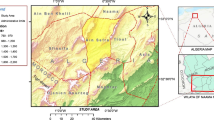Abstract
Aeolian sand landforms in the Yarlung Zangbo River (YZR) valley are a special type of aeolian landform that has attracted the attention of many scholars. However, the spatial distribution as well as the formation mechanism of aeolian sand has rarely been reported with integrated studies. In this paper, for remote sensing interpretation, scanning electron microscopy (SEM), X-ray diffraction (XRD) and particle size distribution (PSD) methods were used to analyze the spatial distribution and the deposition characteristics of aeolian sand. Combined with wind data and topography, the main driving factors and the formation mechanism of aeolian sand landforms were also examined. In the middle reaches of the YZR valley, there is a total of 2324.43 km2 of aeolian sand, especially on the north bank of the wide valleys. In different wide valleys, the aeolian sand landforms exhibit a decreasing trend from the upstream to the downstream regions in both the area and expansion rate of aeolian sand. The cyclonic vortexes generated by the westerly winds and glacial winds are the main driving factors for transporting alluvial sand to the riverbank areas to form aeolian dunes. There are three main types of sand dunes in the river valley: climbing dunes, lee dunes and circumfluent dunes. Climbing dunes and lee dunes are mostly located west of the Jiacha Gorge, and the circumfluent dunes are mostly located east of the Jiacha Gorge.
Similar content being viewed by others
References
Bullard JE, Mc Tainsh GH (2003) Aeolian.fluvial interactions in dryland environments: examples, concepts and Australia case study. Progress in physical geography 27(4): 471–501. https://doi.org/10.1191/0309133303pp386ra
Bullard JE, Nash DJ (1998) Linear dune pattern variability in the vicinity of dry valleys in the southwest Kalahari. Geomorphology 23(1): 35–54. https://doi.org/10.1016/S0169-555X(97)00090-1
Blott SJ, Pye K (2001) GRADISTAT: a grain size distribution and statistics package for the analysis of unconsolidated sediments. Earth Surface Processes and Landforms 26(11): 1237–1248. https://doi.org/10.1002/esp.261
Bagnold RA (1937) Recent explorations in the desert (1932–1936). Geographical Journal 89(3): 265–268.
Clos - Arceduc A (1970) The use of aerial photographs in the study of the lengthening of sand dunes in a direction close to that of the wind, in the Sahara. Photogrammetria 25(5–6): 189–199. https://doi.org/10.1016/0031-8663(70)90006-2
Cheng X (2003) Experimental Research on Sand Incipience Law in Wind-blown-sand Two Phase Flow. PhD thesis, Tsinghua University, Beijing, China. p 48. (In Chinese)
Draut AE (2012) Effects of river regulation on aeolian landscapes, Colorado River, southwestern USA. Journal of GeophysicalRresearch 117(2): 1–22. https://doi.org/10.1029/2011JF002329
Evans JR (1962) Falling and climbing sand dunes in the Cronese ("Cat") Mountain Area, San Bernadino County, California. The Journal of Geology 70(1): 107–113. https://doi.org/10.1086/626798
Eaton KJ (1980) Low. income housing and hurricanes. Wind Engineering 1: 7–21.
Folk RL, Ward WC (1957) Brazos reviver bar - a study in the significance of grain size parameters. Journal of Sedimentary Petrology 27(1): 3–26.
Frank A, Kocurek G (1996) Towards a model for airflow on the lee side of aeolian dunes. Sedimentology 43: 451–458. https://doi.org/10.1046/j.1365-3091.1996.d01-20.x
Greeley R, Iversen JD, Pollack JB, et al. (1974) Wind tunnel simulation of light and dark streaks on Mars. Science 183(4127): 847–849. https://doi.org/10.1126/science.183.4127.847
Tsoar H (1983) Wind tunnel modeling of echo and climbing dunes. Developments in Sedimentology 38: 247–259. https://doi.org/10.1016/S0070-4571(08)70798-2
Li S, Dong GR, Shen JY, et al. (1999) Formation mechanism and development model of aeolian sandy landform in Yarlung Zangbo River Valley. Science in China (Series D) 29(1): 88–96. (In Chinese)
Li S, Wang Y, Ha S, et al. (1997) Classification and development of aeolian sand landform in the Yarlung Zangbo Valley. Journal of Desert Research 17(4): 342–350. (In Chinese)
Li HD, Shen WS, Zou CX, et al. (2010) Spatial distribution and evolution of aeolian sandy land in the areas around Lhasa Airport (Tibet, China) since 1990. Acta Ecologica Sinica 30(21): 5716–5727. (In Chinese)
Mabbutt JA (1977) Desert Landforms, Canberra, Australian. Australian National University Press. p 340.
Smith HTU (1968) Chapter III. Geologic and Geomorphic Aspects of Deserts. In: Desert Biology. pp 51–100.
Shen WS, Li HD, Sun M, et al. (2012) Dynamics of aeolian sandy land in the Yarlung Zangbo River basin of Tibet, China from 1975 to 2008. Global and Planetary Change 86–87: 37–44. https://doi.org/10.1016/j.gloplacha.2012.01.012
Walker I, Nickling WG (2003) Simulation and measurement of surface shear stress over isolated and closely spaced transverse dune in a wind tunnel. Earth Surface Processes and Landforms 28(10): 1111–1124. https://doi.org/10.1002/esp.520
Xie SB, Yu WB, Qu JJ, et al. (2018) Dynamic Environment of Blown Sand at Honglianghe River of Qinghai-Tibet Plateau. Journal of Desert Research 38(2): 219–224. (In Chinese)
Zhu S (2012) River Landform and Geology Environment Evolution in the Yarlung Zangbo River Valley. PhD thesis, Chinese Academy of Geological Sciences, Beijing, China. p 77. (In Chinese)
Zhou N, Zhang CL, Wu XX, et al. (2014) The geomorphology and evolution of aeolian landforms within a river valley in a semi-humid environment: A case study from Mainling Valley, Qinghai—Tibet Plateau. Geomorphology 224: 27–38. https://doi.org/10.1016/j.geomorph.2014.07.012
Zhou N, Zhang CL, Liu YG (2011) Variation of Grain Size on Surface of Barchans in Maiming Great Valley, Yarlung Zangbo River. Scientia Geographica Sinica 31(8): 958–963. (In Chinese)
Zeng LH, Li S, Li BS, et al. (2007) The Genesis and Environmental Significance of the Sandy Sediments of the Upper Basuo Formation in Western Hainan Island. Geological Review 53(6): 783–791. (In Chinese)
Zakrzews B (1974) Geomorphology in Deserts — Cooke RU and Warren A. Professional Geographer 26(4): 455–456.
Acknowledgments
This study is financially supported by the Foundation of China Geological Survey (DD20160297), National Natural Science Foundation of China (Grant No. 41877235) and the National Key Research and Development Program of China (Grant No. 2017YFC1501000).
Author information
Authors and Affiliations
Corresponding author
Rights and permissions
About this article
Cite this article
Liu, Y., Wang, Ys. & Shen, T. Spatial distribution and formation mechanism of aeolian sand in the middle reaches of the Yarlung Zangbo River. J. Mt. Sci. 16, 1987–2000 (2019). https://doi.org/10.1007/s11629-019-5509-5
Received:
Revised:
Accepted:
Published:
Issue Date:
DOI: https://doi.org/10.1007/s11629-019-5509-5




